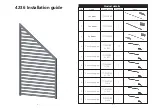
1.4.3. Electrical connections
Electrical connections must be made by certified electri-
cians in compliance with all international, national, state
and local regulations. For more information about require-
ments see the relevant sections dealing specifically with
electrical connections (if applicable).
1.4.4. Hazardous liquids
The product is designed for use in liquids that can be
hazardous to your health.
WARNING:
Make sure that all personnel who work
with hazardous liquids use suitable protective equip-
ment.
1.4.5. Specific operational hazards
Specific operational hazards are listed under its respective
section.
1.4.6. Specific hazards while performing maintenance
Specific hazards while performing maintenance on the
product are listed under its respective section.
2. HANDLING
Upon receipt always:
• Check the packing slip against the goods received.
• If delivered with a drive unit, check that the drive unit
specification and technical information are included.
• Inspect the packaging for signs of damage in transit.
• Carefully remove the packaging. Pay special atten-
tion to cavities and make sure they are free of packag-
ing material.
• Inspect the Sterimixer/Sanimixer for any visible signs
of damage. Pay special attention to make sure the
bearings do not show any sign of cracks.
• Report any damage to the carrier.
Approximate weight of the different components of the
Sterimixer/Sanimixer is specified in table 1:
STRONG MAGNETIC FIELDS HAZARD:
The Ster-
imixer/Sanimixer impeller and magnetic rotor include
strong magnets with the associated risk of pinching fin-
gers and permanently damaging magnetic cards (e.g.
credit cards) if being close to these components.
HAZARD FOR WEARERS OF CARDIAC PACE-
MAKER:
The Sterimixer/Sanimixer impeller and mag-
netic rotor include strong magnets thus personnel
equipped with pacemaker shall not handle these com-
ponents.
CAUTION:
Ensure that suitable lifting equipment is
chosen and correctly used.
CAUTION:
If the Sterimixer/Sanimixer is not to be in-
stalled immediately, the Sterimixer/Sanimixer should
be repacked in the original package and stored in a suit-
n
Figure 1
Mounting the bearing unit on the weld plate
in the vessel. The figure shows the bearing unit and the
PTFE-washer. Use a torque wrench (refer to table 2 for
recommended torque).
able storage after receipt and inspection. The following
should be considered with regards to storage:
The storage shall be a clean, dry location free from
vibration. If stored in a moist or dusty atmosphere,
further protect the Sterimixer/Sanimixer with a suitable
cover.
3. INSTALLATION AND START-UP
+
NOTICE:
Refer to the Steridose welding manual on
www.steridose.com for correct installation of the Sterim-
ixer/Sanimixer weld plate. The remainder of this man-
ual concerns the installation of a Sterimixer/Sanimixer
with the weld plate correctly welded in place in the
tank.
3.1. Mounting of the bearing unit
The bearing materials used are either Tungsten Carbide
(TC), Silicon Carbide (SiC) or Dri-amond™ (diamond
coated SiC), which are very hard but brittle materials. It
is therefore important that the bearing is protected from
physical impact damage. It is also of the utmost impor-
tance that the bearing surfaces are kept free from particles
to avoid damage or disturbances of the bearing function
during operation.
CAUTION:
Before the bearing unit and the impeller
are to be mounted, the vessel, pipes and other installed
parts must be thoroughly cleaned from dirt and in
particular loose metal particles (can occur in new ves-
sels, where machined stainless steel particles might
have acquired magnetic properties). Wetted Sterim-
ixer/Sanimixer components can otherwise be perma-
nently damaged. Ensure the vessel has been allowed to
cool down, drained, depressurized and ventilated from
possible gasses or vapours.
Carefully fit the bearing unit together with the PTFE
washer to the weld plate and tighten to a proper torque
(Table 2). Make sure that the PTFE washer is centered
correctly. Steridose have designed a tool for this purpose
that facilitates mounting the bearing unit in hard-to-access
places. See section 3.3.
www.steridose.com
Installation & Operation
|
3


































